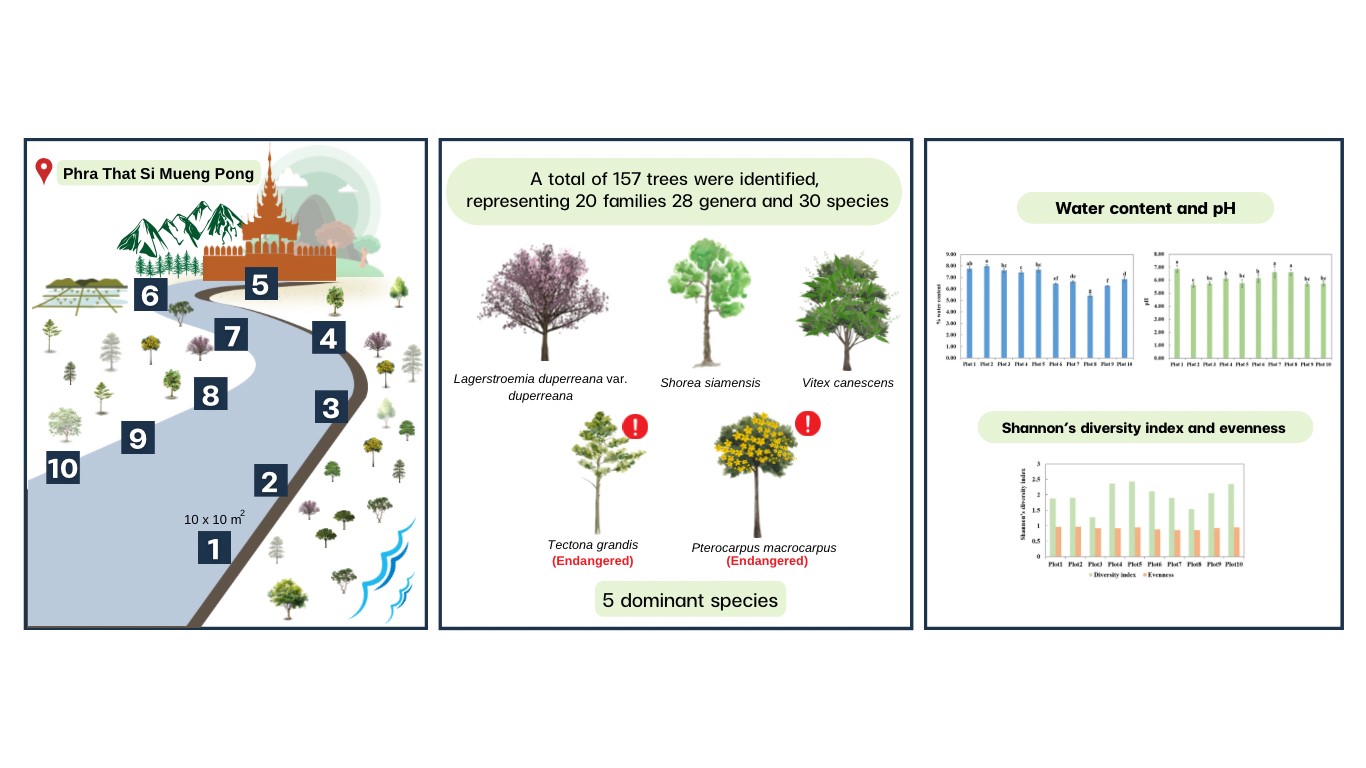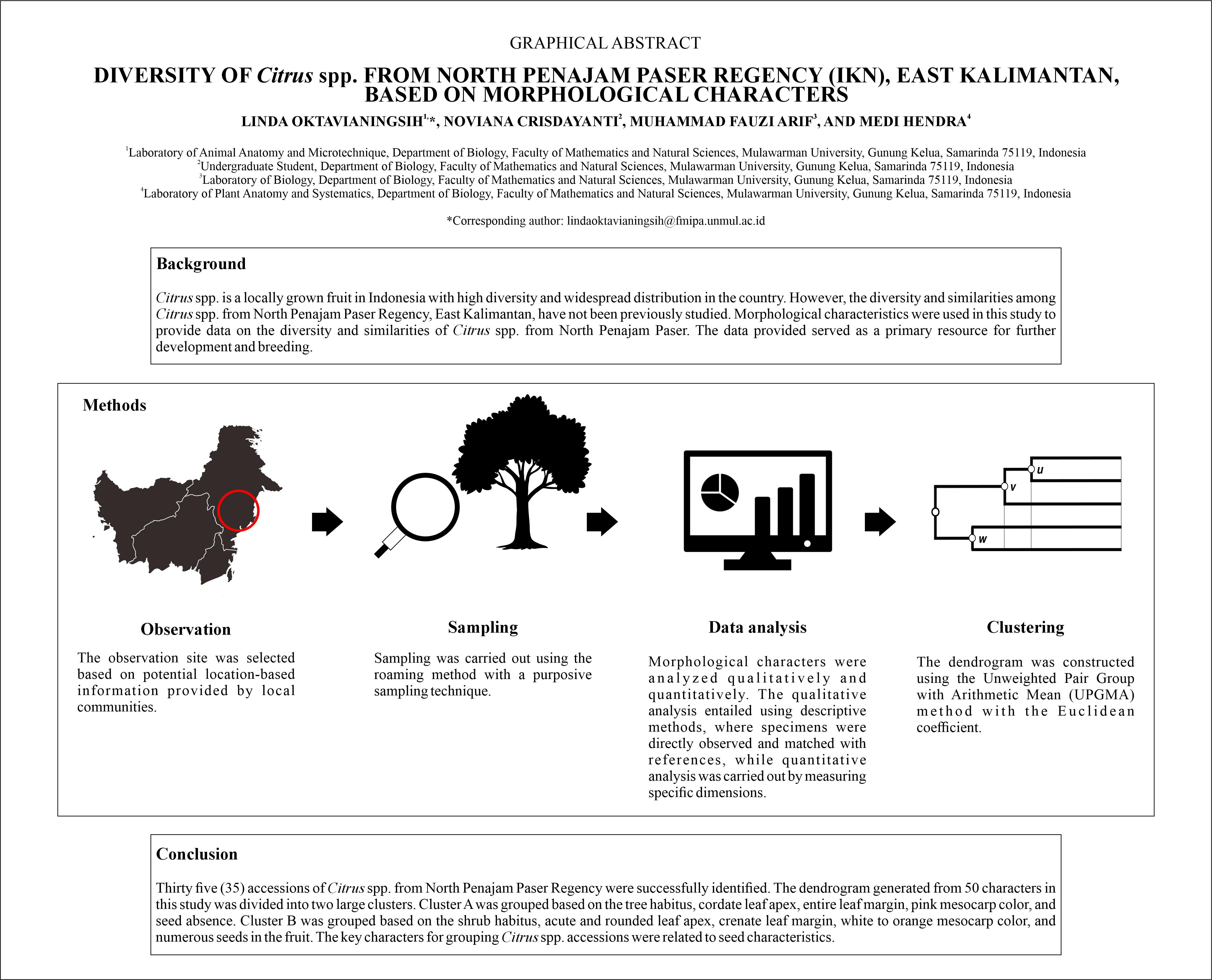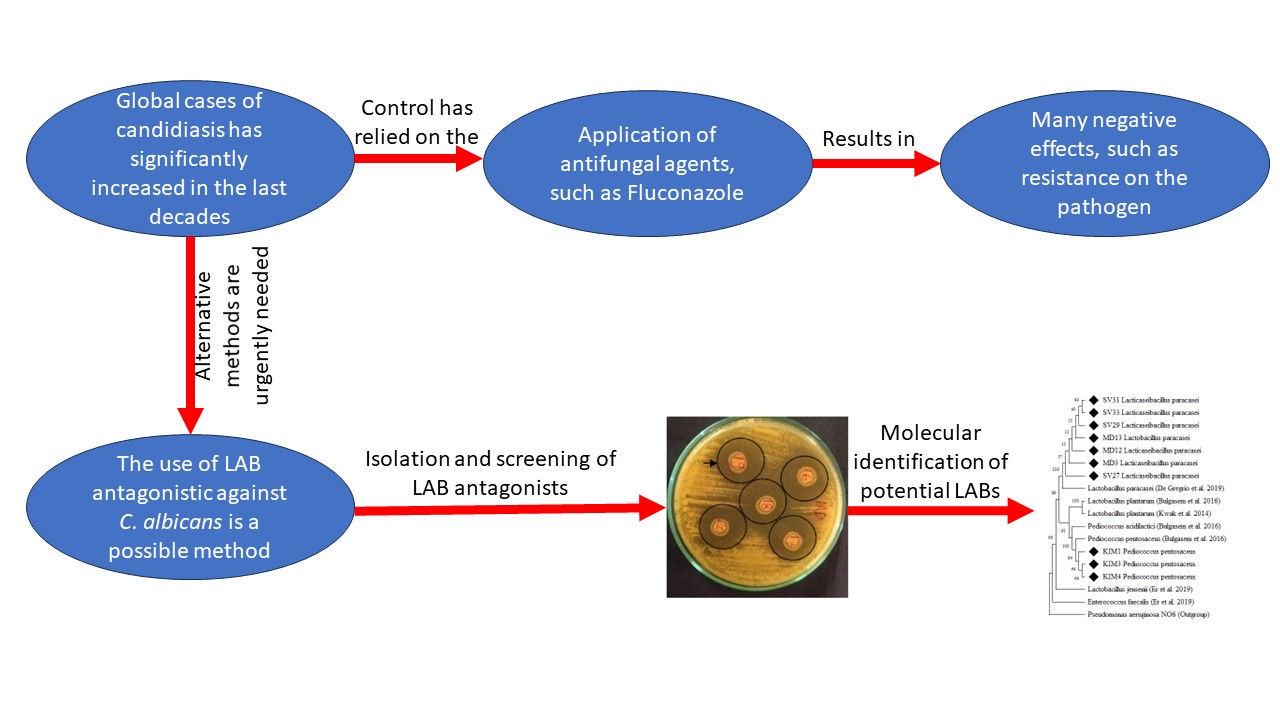DIVERSITY, ECOLOGY AND CONSERVATION STATUS OF NEPENTHES IN WEST SUMATRA PROVINCE, INDONESIA
Downloads
Nepenthes is the largest carnivorous plant genus present in Indonesia. There are 39 species of Nepenthes pitcher plants recorded in Sumatra from lowland to montane forests, and 34 of them are endemic; this represents the greatest species diversity of Nepenthes after Borneo. Field studies were conducted in 2021 and 2022 to increase our knowledge of the diversity, habitats and distributions of Nepenthes in West Sumatra province. Twenty-three species of Nepenthes were recorded from the province, consisting of 15 highland species, 4 mid-elevation species and 4 lowland species. Ecophysiological studies conducted at Bukit Malalak showed clumped distributions of N. bongso, N. dubia, N. eustachya and N. rhombicaulis. Foliar and pitcher fluid nutrient concentrations were found to be similar to those cited in other recent studies although growth rates were slightly more rapid than at Gunung Talang. Bukit Malalak is a new locality for two threatened species, namely N. dubia (CR) and N. rhombicaulis (VU), enlarging their extents of occurrence. In total, nine species from West Sumatra are threatened and conservation actions are urgently needed for these and other Nepenthes species remaining on the island.
Downloads
Adam J. 2002. Demographic study of Nepenthes species (Nepenthaceae) recorded along the trail to the summit of Mount Kinabalu in Sabah, Malaysia. Pakistan Journal of Biological Sciences 5(4): 419-426. DOI: 10.3923/pjbs.2002.419.426
Austin KG, Schwantes A, Gu Y, Kasibhatla PS. 2019. What causes deforestation in Indonesia? Environmental Research Letters 14(2): 024007. DOI: 10.1088/1748-9326/aaf6db
Brearley FQ, Mansur M, Eichhorn MP. 2023. Spatial patterning of Gonystylus brunnescens in eastern Borneo. Folia Oecologica 50(1): 55-59. DOI: 10.2478/foecol-2023-0004
Brearley FQ, Saner P, Uchida A, Burslem DFRP, Hector A, Nilus R, Egli S. 2016. Testing the importance of a common ectomycorrhizal network for dipterocarp seedling growth and survival in tropical forests of Borneo, Plant Ecology & Diversity 9(5-6): 563-576. DOI: 10.1080/ 17550874.2017.1283649
Clarke CM. 2001. Nepenthes of Sumatra and Peninsular Malaysia. Natural History Publications, Kota Kinabalu, Sabah, Malaysia.
Clarke CM 2014. Nepenthes naga. The IUCN Red List of Threatened Species 2014: e.T48994529A49009797. https://dx.doi.org/10.2305/IUCN.UK.2014-1.RLTS.T48994529A49009797.en. Accessed on 29 March 2023.
Clarke CM, Davis T, Tamin R. 2003. Nepenthes izumiae (Nepenthaceae): a new species from Sumatra. Blumea 48(1): 179-182. DOI: 10.3767/ 000651903X686141
Clarke CM, Cantley R, Nerz J, Rischer H, Wistuba A. 2000a. Nepenthes dubia. The IUCN Red List of Threatened Species 2000: e.T39657A10254648. https://dx.doi.org/10.2305/IUCN.UK.2000.RLTS.T39657A10254648.en. Accessed on 30 December 2022.
Clarke CM, Cantley R, Nerz J, Rischer H, Wistuba A. 2000b. Nepenthes rhombicaulis. The IUCN Red List of Threatened Species 2000: e.T39693A10251994. https://dx.doi.org/10.2305/IUCN.UK.2000.RLTS.T39693A10251994.en. Accessed on 04 February 2023.
Clarke CM, Cantley R, Nerz J, Rischer H, Wistuba A. 2000c. Nepenthes talangensis. The IUCN Red List of Threatened Species 2000: e.T39701A10256061. https://dx.doi.org/10.2305/IUCN.UK.2000.RLTS.T39701A10256061.en. Accessed on 04 February 2023.
Clarke C, Cross A, Rice B. 2018. Conservation of carnivorous plants. In: Carnivorous plants: physiology, ecology, and evolution. Eds: AM Ellison L Adamec. Oxford University Press, UK. pp. 375-388. DOI: 10.1093/oso/9780198779841.003.0027
Cross AT, Krueger TA, Gonella PM, Robinson AS, Fleischmann AS 2020. Conservation of carnivorous plants in the age of extinction. Global Ecology and Conservation 24: e01272. DOI: 10.1016/ j.gecco.2020.e01272
Damit A, Nilus R, Suleiman M. 2017. Population structure and dispersion pattern of Nepenthes along the Kaingaran trail of Mount Trus Madi, Sabah, Borneo. Sepilok Bulletin 25 & 26(1): 1-11.
Dinas Kehutanan Sumatra Barat. 2018. Sekilas hutan Sumbar [A glimpse at the forests of West Sumatra] https://dishut.sumbarprov.go.id/details/pages/1#:~:text=Sumatera%20Barat%20terletak%20di%20pesisir,sekitar%2042%2C2%20ribu%20km2. Accessed on 30 Jan 2023.
Hernawati N, Clarke CM 2014. Nepenthes adnata. The IUCN Red List of Threatened Species 2014: e.T39638A19630641. https://dx.doi.org/10.2305/ IUCN.UK.2014-1.RLTS.T39638A19630641.en. Accessed on 29 March 2023.
Hernawati N, Clarke CM, Lee C. 2014. Nepenthes tenuis. The IUCN Red List of Threatened Species 2014: e.T39703A21845410. https://dx.doi.org/10.2305/ IUCN.UK.2014-1.RLTS.T39703A21845410.en. Accessed on 29 March 2023.
Hernawati, Zuhud EAM, Prasetyo LB, Soekmadi R. 2022a. Synopsis of Sumatran Nepenthes. Biodiversitas 23(8): 4243-4255. DOI: 10.13057/biodiv/d230848
Hernawati, Satria R, Lee CC. 2022b. Nepenthes harauensis, a new species of Nepenthaceae from West Sumatra. Reinwardtia 21(1): 19-23. DOI: 10.14203/ reinwardtia.v21i1.4306
IUCN. 2001. IUCN Red List Categories and Criteria: Version 3.1. IUCN Species Survival Commission. IUCN, Gland, Switzerland and Cambridge, UK.
Lee CC, Hernawati, Akhriadi P. 2006. Two new species of Nepenthes (Nepenthaceae) from North Sumatra. Blumea 51(3): 561-568. DOI: 10.3767/ 000651906X622120
Linkie M, Rood E, Smith RJ. 2010. Modelling the effectiveness of enforcement strategies for avoiding tropical deforestation in Kerinci Seblat National Park, Sumatra. Biodiversity and Conservation 19(4): 973-984. DOI: 10.1007/s10531-009-9754-8
Ludwig JA, Reynold JS. 1988. Statistical Ecology: a Primer on Methods and Computing. John Wiley and Sons, New York, USA.
Margono BA, Turubanova S, Zhuravleva I, Potapov P, Tyukavina A, Baccini A , Goetz S & Hansen MC. 2012. Mapping and monitoring deforestation and forest degradation in Sumatra (Indonesia) using Landsat time series data sets from 1990 to 2010. Environment Research Letters 7(3): 034010. https://dx.doi.org/10.1088/1748-9326/7/3/034010
Mansur M, Brearley FQ. 2008. Ecological studies on Nepenthes at Barito Ulu, Central Kalimantan, Indonesia. Jurnal Teknologi Lingkungan 9(3): 271-276. DOI: 10.29122/jtl.v9i3.471
Mansur M, Brearley FQ, Esseen PJ, Rode-Margono EJ, Tarigan MRM. 2021. Ecology of Nepenthes clipeata on Gunung Kelam, Indonesian Borneo. Plant Ecology and Diversity 14(3-4): 195-203. DOI: 10.1080/ 17550874.2021.1984602
Mansur M, Salamah A, Mirmanto E. 2022a. Diversity of Nepenthes species in North Sumatra province. Berita Biologi 21(3): 199-209. DOI: 10.14203/ beritabiologi.v21i3.4389
Mansur M, Salamah A, Mirmanto E, Brearley FQ. 2022b. Nutrient concentrations in three Nepenthes species (Nepenthaceae) From North Sumatra. Reinwardtia 21(2): 55-62. DOI: 10.14203/reinwardtia.v21i2.4391
Mansur, M, Salamah A, Mirmanto E, Brearley FQ. Ecology of Nepenthes on Mount Talang, West Sumatra, Indonesia. Tropical Ecology (in review).
Metusala M, Al Farishy DD, Jebb MHP. 2020. Nepenthes putaiguneung (Nepenthaceae), a new species from highland of Sumatra, Indonesia. Phytotaxa 454(4); 285-292. DOI: 10.11646/phytotaxa.454.4.6
Moran JA, Clarke CM. 2010. The carnivorous syndrome in Nepenthes pitcher plants: current state of knowledge and potential future directions, Plant Signaling and Behavior 5(6): 644-648. DOI: 10.4161/ psb.5.6.11238
Moran JA, Clarke CM, Gowen BE. 2012. The use of light in prey capture by the tropical pitcher plant Nepenthes aristolochioides. Plant Signaling & Behavior 7(8): 957-960. DOI: 10.4161/psb.20912
Morisita M. 1959. Measuring of the dispersion of individuals and analysis of distribution patterns. Memoirs of the Faculty of Science, Kyushu University, Series E (Biology) 2(4): 215-235.
Mueller-Dombois D, Ellenberg H. 1974. Aims and Methods of Vegetation Ecology. John Wiley and Sons, New York, USA.
Nerz J. 2005. Sumatra, a centre of evolution in the genus Nepenthes?! Acta Botanica Gallica 152(2): 262-263. DOI: 10.1080/12538078.2005.10515483
Nerz J, Wistuba A. 1994. Five new taxa of Nepenthes (Nepenthaceae) from North and West Sumatra. Carnivorous Plant Newsletter 23(4): 101-114.
Ochiai A. 1957. Zoogeographic studies on the soleoid fishes found in Japan and its neighbouring regions. Bulletin of Japanese Society of Scientific Fisheries 22(9): 526-530. DOI: 10.2331/suisan.22.526
Pavlovič A, Singerová L, Demko V, Hudák J. 2009. Feeding enhances photosynthetic efficiency in the carnivorous pitcher plant Nepenthes talangensis. Annals of Botany 104(2): 307-314. DOI: 10.1093/aob/ mcp121
Pavlovič A, Singerová L, Demko V, Šantrůček J & Hudák J. 2010. Root nutrient uptake enhances photosynthetic assimilation in prey-deprived carnivorous plant Nepenthes talangensis. Photosynthetica 48(2): 227-233. DOI: 10.1007/s11099-010-0028-1
Phillipps A, Lamb A. 1996. Pitcher-Plants of Borneo. Natural History Publications, Kota Kinabalu, Sabah, Malaysia.
Victoriano M. 2021. A new species of Nepenthes (Nepenthaceae) and its natural hybrids from Aceh, Sumatra, Indonesia. Reinwardtia 20(1): 17-26. DOI: 10.14203/reinwardtia.v20i1.3932
Zulkarnaen RN, Peniwidiyanti, Rivai RR, Helmanto H, Wanda IF. 2017. Struktur dan asosiasi komunitas tumbuhan bawah di Resort Cikaniki, Taman Nasional Gunung Halimun Salak [Structure and associations of understorey plants at Cikaniki resort, Gunung Halimun Salak National Park]. Jurnal Ilmu Alam dan Lingkungan 8(2): 21-30. DOI: 10.20956/jal.v8i16.2985
Copyright (c) 2023 Muhammad Mansur, Andi Salamah, Edi Mirmanto, Francis Q. Brearley

This work is licensed under a Creative Commons Attribution-NonCommercial-NoDerivatives 4.0 International License.
Authors who publish with this journal agree with the following terms:
- Authors retain copyright and grant the journal right of first publication, with the work 1 year after publication simultaneously licensed under a Creative Commons attribution-noncommerical-noderivates 4.0 International License that allows others to share, copy and redistribute the work in any medium or format, but only where the use is for non-commercial purposes and an acknowledgement of the work's authorship and initial publication in this journal is mentioned.
- Authors are able to enter into separate, additional contractual arrangements for the non-exclusive distribution of the journal's published version of the work (e.g., post it to an institutional repository or publish it in a book), with an acknowledgement of its initial publication in this journal.
- Authors are permitted and encouraged to post their work online (e.g., in institutional repositories or on their website) prior to and during the submission process, as it can lead to productive exchanges, as well as earlier and greater citation of published work (See The Effect of Open Access).






























